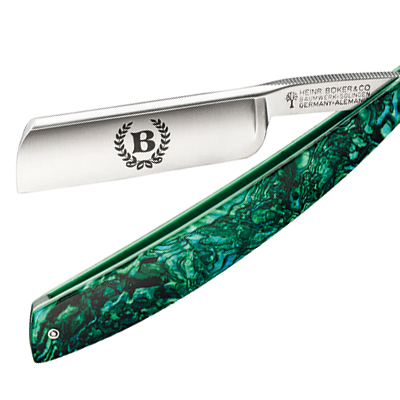Straight Razor

For our carbon steel straight razors, we use reliable silver steel that offers excellent edge retention while being very tough and elastic.
The basic material is a round rod cut to length to create the so-called cropped piece. The cropped piece is brought to a red heat and then drop forged with a rammer of 690 kilograms. The fresh slugs need to spend two days in the annealing oven to be cooled down to 200°C. Once cooled, the slugs are deburred, which means that the excess material created during the forging process is removed. The slugs are straightened on a 200-ton press before going to the hardening shop. Here, the slugs are hardened and annealed in order to achieve the perfect combination of edge retention and elasticity. Here, the slugs are hand-ground in 18 steps – from coarse grinding to milling to fine-grinding. Between the individual processing steps, the blades are cleaned, checked and straightened if necessary.
We give all our straight razor blades an extra hollow grind with a ridge. The ridge is located in front of the hollow and just behind the bevel, which also shows a slight hollow grind. The ridge makes it possible to grind the blade extremely thin and gives the blade enough stiffness despite its elasticity. All over the world, only a handful of the best, highly specialized grinding experts possess the skill to make straight razors this way. Depending on the design, the final processing step in the shop is matting or polishing. Straight razors are then riveted with nickel silver rivets, washers and spacers. Wood and horn handles require very delicate handling, since too much pressure might tear these natural materials. Lastly, the blade goes through a manual stropping process on several whetstones of decreasing grain size. The edge of the buffed straight razor is tested on a loosely held human hair. Lastly, the blade goes through a manual stropping process on several whetstones of decreasing grain size. The edge of the buffed straight razor is tested on a loosely held human hair.
Straight razor shapes are mainly determined by national and local traditions as well as personal preferences. However, the different shapes offer different advantages. The width of the blade is given in relation to a one inch. An 8/8" blade is one inch wide, while a 4/8" blade measures half an inch. The most common blade is a 5/8". Blades of 4/8"and smaller are mainly used by barbers and hairdressers to shave the neck or blend layers. A wider and heavier blade glides more securely across the skin and can pick up more soap and bristles before it needs to be cleaned. Narrower blades are well suited for tight spots and contours.
Straight razors come with several point styles, including round, notched, French and Spanish. The round point has the lowest risk of injury. It is recommended for beginners. With their clearly defined edges and profiles, the other points offer certain advantages for achieving precise lines and contours.
